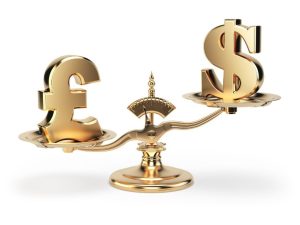DOLLAR GAINS GROUND AFTER FED DELIVERS BUMPER 50 BASIS POINT RATE CUT
The dollar edged higher in choppy trading after the Federal Reserve on Wednesday cut interest rates by half a percentage point, citing greater confidence that inflation will continue to recede to the U.S. central bank’s 2 per cent annual target. The Fed cut the overnight rate to the 4.75 per cent-5.00 per cent range, and policymakers see the Fed’s benchmark rate falling by another half of a percentage point by the end of this year, another full percentage point in 2025, and by a final half percentage point in 2026 to end in a 2.75 per cent-3.00 per cent range. The dollar initially trading lower following the Fed announcement, but pared those losses after Chair Jerome Powell finished his press conference. The dollar index was last up 0.05 per cent on the day at 100.970. It earlier reached 100.21, the lowest since July 2023. The euro dropped 0.01 per cent to $1.111275. The greenback was flat at 142.370 Japanese yen. “It’s a more dovish cut. It certainly wasn’t a hawkish cut,” said Vassili Serebriakov, FX & macro strategist at UBS in New York. “The way we thought about it before the announcement is that you know a 50-basis point cut is dollar negative. If they had cut by 25 bps, there were different scenarios where the dollar could perform. But a 50-basis point cut is unambiguously dollar negative,” Serebriakov added. During his press conference, Powell said he does not see any indication of a recession or even an economic downturn ahead. “I don’t see anything in the economy right now that suggests that the likelihood of a recession,” Powell said. “You see growth at a solid rate, you see inflation coming down, and you see a labor market that’s still at very solid levels.”
STERLING HOLDS GAINS ON EVE OF UK INFLATION DATA, US RATE DECISION
The British pound rose against the dollar on Wednesday after UK inflation data boosted the market view that the Bank of England will keep interest rates steady on Thursday, in contrast with an expected start to the U.S. policy easing cycle later on Wednesday. Sterling gained 0.49% to $1.3227, a session high, recouping Tuesday’s losses. The Bank of England is widely anticipated to keep interest rates at 5% on Thursday, after official figures showed inflation stood at an annual rate of 2.2% in August, unchanged from July, despite a pick up in price growth in the services sector. Meanwhile, industry data showed British supermarket sales growth slowed over the last month as consumers trimmed spending after their summer holidays. “Looking through the Bank of England’s range of underlying services measures, we still see some marginal improvement in the data despite the uptick in the headline services measure, with underlying inflation continuing to ease. This is good news for the MPC,” said Sanjay Raja, Chief UK Economist at Deutsche Bank, referring to the BoE’s Monetary Policy Committee. “That said, today’s data won’t be enough to trigger a surprise rate cut tomorrow,” Raja added. Futures markets now imply a smaller chance of a quarter point cut, at 26%, versus about 38% at the beginning of the week. “Sterling looks pretty strong,” said ING currency strategist Francesco Pesole, adding euro-sterling was not likely to jump back to 85 pence for now. The euro slipped 0.25% against the pound to 84.235 pence. “We are still expecting a bit of a weaker year end for sterling,” if the BoE starts moving a bit faster with rate cuts, Pesole said. Looking past the MPC decision on Thursday, markets are wagering on 50 basis points of cuts in total from now until the end of the year. The BoE cut rates by a quarter of a point last month. Slow steady progress in reducing inflation “ought to still justify a gradualist approach” in easing monetary policy, analysts at Lloyds Bank wrote in a note.

DOLLAR GAINS AGAINST YEN AFTER BOJ HOLDS CAUTIOUS STANCE
The dollar strengthened against the yen today after the Bank of Japan left interest rates unchanged and indicated that it was not in a hurry to hike them again. The BoJ could afford to spend time eyeing the fallout from global economic uncertainties, Governor Kazuo Ueda said in a press conference following the central bank’s move, adding that its monetary policy decision will be based on “economic, price and financial developments.” The BOJ had kept rates steady at 0.25% as widely expected. The dollar rose 1.06% to 144.14 yen, after hitting its highest level in a little over two weeks. The euro also strengthened against the yen, gaining 0.96% to 160.65 . The dollar has been choppy since after the U.S. Federal Reserve kicked off its monetary policy easing cycle by cutting interest rates by 50 basis points on Wednesday. Against the dollar, however, the euro weakened 0.16% to $1.114300. The U.S. dollar index, which measures the greenback against major currencies, gained slightly at 100.96 and just above a one-year low. “There’s a sense in the market that the Bank of Japan doesn’t need to hike rates and also we’re turning to more the political situation in Japan,” said Adam Button, chief currency analyst at ForexLive in Toronto. Markets imply a near 41% chance the Fed will deliver another 50 bps in November and have 70 bps priced in by year-end. Rates are seen at 2.85% by the end of 2025, which is now thought to be the Fed’s estimate of neutral. That dovish outlook has bolstered hopes for continued U.S. economic growth and sparked a major rally in risk assets. Currencies leveraged to global growth and commodity prices also benefited, with the Aussie surpassing $0.6800. It was last down 0.37% to $0.67895.
STERLING RISES VS DOLLAR, EURO BOOSTED BY STRONG UK RETAIL SALE DATA
The British pound strengthened against other major currencies in the European session on Friday, after data showed that U.K. retail sales grew more than expected in August as warmer weather boosted food and clothing sales. Data from the Office for National Statistics showed that the retail sales grew 1.0 percent on a monthly basis in August, faster than the 0.7 percent rise in July. Sales were forecast to climb moderately by 0.3 percent. On a yearly basis, retail sales growth improved to 2.5 percent from 1.5 percent in July. This was the largest annual growth since February 2022 and stronger than the expected increase of 1.4 percent. A survey from the Gfk market research group showed that U.K. consumer confidence declined sharply in September. The confidence indicator posted -20 compared to -13 in August. The British sterling held steady against its major rivals in the Asian trading today. In the European trading today, the pound rose to a 2-1/2-year high of 1.3341 against the U.S. dollar and more than a 2-year high of 0.8381 against the Euro, from early lows of 1.3272 and 0.8407, respectively. If the pound extends its uptrend, it is likely to find resistance around 1.34 against the greenback and 0.82 against the euro. Against the Swiss franc and the yen, the pound advanced to nearly a 2-month high of 1.1300 and nearly a 3-week high of 191.12 from early lows of 1.1240 and 188.73, respectively. The pound may test resistance near 1.15 against the franc and 195.00 against the yen. Looking ahead, Canada retail sales data for July, Canada industrial product, new housing and raw materials price indices for August and U.S. Baker Hughes oil rig count data are slated for release in the New York session. At 10:00 am ET, the European Commission is slated to issue euro area flash consumer sentiment survey data. The confidence index is forecast to improve to -13.0 in September from -13.5 in August.

CANADIAN DOLLAR CLINGS TO WEEKLY GAIN AS RETAIL SALES BEAT ESTIMATES
The Canadian dollar steadied against its U.S. counterpart on Friday as domestic data showed retail sales rising more than expected in July and despite the greenback notching gains against some other major currencies. The loonie was trading nearly unchanged at 1.3560 to the U.S. dollar, or 73.75 U.S. cents, after moving in a range of 1.3543 to 1.3589. For the week, the currency was up 0.2%. Canadian retail sales grew by 0.9% in July from June, eclipsing forecasts for a gain of 0.6%, while a preliminary estimate showed sales up 0.5% in August. The data “may ease concerns that the economy has slowed sharply,” Shaun Osborne, chief currency strategist at Scotiabank, said in a note. “That should help limit upside movement in the USD at least.” The U.S. dollar strengthened against a basket of major currencies after the Bank of Japan left interest rates unchanged. The American currency was clawing back some declines after the Federal Reserve kicked of its easing cycle on Wednesday with a half-percentage-point reduction in interest rates. The Fed’s larger-than-usual rate cut has led to investors raising bets the BoC would increase the size of its cuts. The central bank has eased three times since June, moving in quarter-percentage-point steps. Still, BoC Governor Tiff Macklem said adoption of artificial intelligence by businesses could add to price pressures in the short term by boosting demand. The price of oil, one of Canada’s major exports, added to its weekly gain, advancing 0.5% to $72.34 a barrel. Canadian bond yields moved higher across the curve. The 10-year was up 1 basis point at 2.937%, having rebounded from a 16-month low on Tuesday at 2.829%.

- CAPITALDIGEST MARKET REVIEW , 03/11/2025November 3, 2025
- CAPITALDIGEST DAILY NEWS, 03/11/2025November 3, 2025
- CAPITALDIGEST MARKET REVIEW, 22/09/2025September 22, 2025
Enter your email address for receiving valuable newsletters.
- CAPITALDIGEST DAILY NEWS, 03/11/2025NNPCL WEIGHS OVERHAUL, REPURPOSING OPTIONS FOR REFINERIES The Nigerian National Petroleum Company Limited has said...November 3, 2025
- CAPITALDIGEST MARKET REVIEW, 22/09/2025STERLING RISES AGAINST DOLLAR ON FED-BOE POLICY DIVERGENCE Sterling gained against the dollar on Tuesday,...September 22, 2025
- CAPITALDIGEST DAILY NEWS, 22/09/2025OIL REFORMS DRIVE $18.2BN DEALS – FG Nigeria’s oil and gas sector is experiencing a...September 22, 2025












